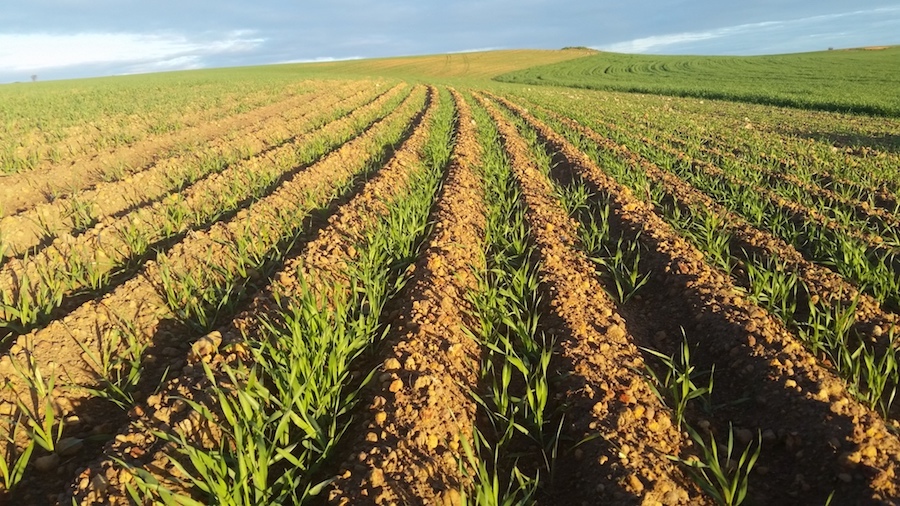With the advent of rock-crushing machines, growers can now break up most surface and shallow subsurface rocks, boosting yield and turning previously unusable country into arable paddocks. Machines work like a wood plane or cheese grater, cracking and peeling the rock. A heavy roller behind then crushes the now-weakened rock.
This article provides some tips on using rock-crushing machines in the paddock.
Correct set-up
Machines need to be set up and used correctly in the paddock for a good outcome. Hitch height and working depth are key settings to check. If the hitch is too high or low, the machine will be pulled at the wrong angle and will not be as effective.
Tyre pressure can affect hitch height. Consult the machinery manual, which will have detailed diagrams and instructions. Manufacturers and sellers can usually assist with set-up.
Working depth will depend on where the rock is in the profile you are trying to break. When in doubt, start shallower then increase depth. Start at the shallowest setting for hard surface rocks, increasing depth as rocks become softer and deeper.
Working too deep for the situation risks breaking tynes or other parts of the machine, particularly in older machines. On newer hydraulic machines, hydraulic tynes respond individually to the rock. If the rock is too hard, they will ride up and over it.
Do a trial pass or two to get the settings right. Trial passes are recommended each time you change paddock or soil situation. One common error is having a machine set up to deal with softer gravel in the subsoil – deeper, softer rock – then trying to use those settings on exposed, harder surface rock. This is when equipment starts to struggle and break. Newer hydraulic machines are more tolerant, but it still saves time and money to get the set-up right first.
Patience
Rock crushing is slow work and, like other soil amelioration practices, is best done properly once. In most cases, three passes will do a good job. The third pass should level the surface, though some areas might need a fourth pass. One trial on laterite gravels broke down watermelon-sized rocks into golf ball-sized rocks in two passes. Let the machine and paddock guide whether another pass is needed.
The surface will be rough if the machine has been operating too deep, too fast or both. The job is ‘done’ when the machine starts pulling very smoothly.
At seeding time, if the seeder bar flicks up boulders, this is an indication more passes of rock crushing were needed.
Speed and depth
Working too deep or too fast can mean breakages and a poor job. Clues you are working too deep include:
- very bumpy ride;
- spinning or wearing out tyres;
- bringing up big boulders;
- stopping frequently; and
- making a mess of the paddock.
Machines typically work at about 10 kilometres per hour (one hectare per hour with three passes). Working too deep runs a risk of sudden stopping. Machines with hydraulic tynes that ride over obstacles can reduce this risk.
Adjust in the paddock to find the right combination of depth and speed.
Situations in which to exercise caution
Harder rocks
Machines can bust up most, but not all, rocks. Granite is too hard for the machines, as are hard and large basalt rocks.
How well rock breaks will depend on rock type, speed, depth and conditions. Some rock softens and is best worked when wet (for example, sheet ironstone). One way to test how a rock will respond to crushing is to hit it with a sledgehammer. If the sledgehammer bounces back at you, the rock is too hard. If it cracks or shatters (such as quartz), rock crushing will work.
When using hydraulic machines on harder rocks, front tynes can be lifted out of the ground so more pressure can be applied to the rear tynes. However, if the machine starts lifting up large pieces of rock, you will need to use all of the tynes.

Crop seeded into reefinated soil.
Soft sand
Loose stones on soft ground are difficult for the machine. If there are boulders in soft sand, work fast (about 12km/hr) and shallow to hit the rock with force while it is still anchored in the ground. Repeated passes will soften the soil around the rock and increase the risk of rocks being pushed into the soil rather than crushed. Working shallow also reduces the risk of picking up the boulders instead of crushing them.
Wet soil
Working too wet on clayey soils makes a sticky mess. It is possible to get bogged in the pockets of clay between the rocks. Some machines have rib cleaners on the back, which make working in wet conditions easier. If it is too wet, wait until it is drier.
Wet stubble
Some machines have some difficulties with wet stubble flexing and snaring instead of cutting. This is less of an issue with newer hydraulic machines. It is best to wait for the stubble to dry.
Preparing for seeding
In some cases, the surface will also benefit from a light level afterwards. This is important if the ground is still rough and machinery risks getting bogged.
Rock crushing can stimulate weeds; a robust weed control program will help. Take care with herbicides as soil renovation can change how pre-emergent herbicides behave in the soil. Weed issues make canola an attractive choice; however, canola can be difficult to establish in year one.
Timing
For paddocks worked during the growing season, there is often an opportunity to sow a late summer crop for some cover and protection from wind erosion.

























































